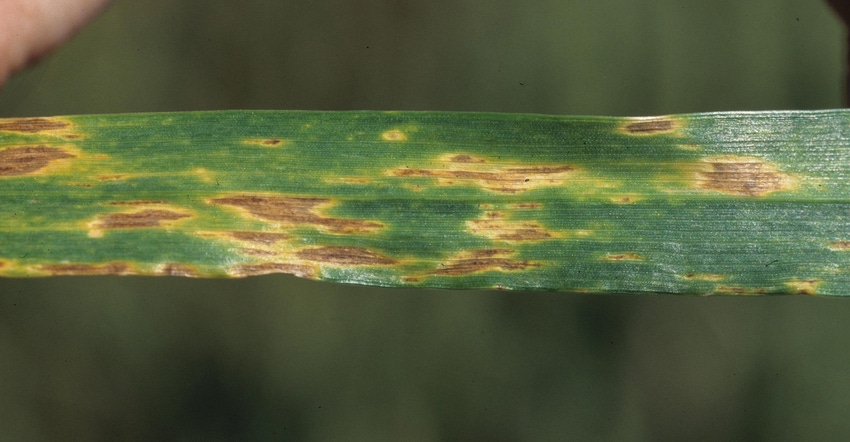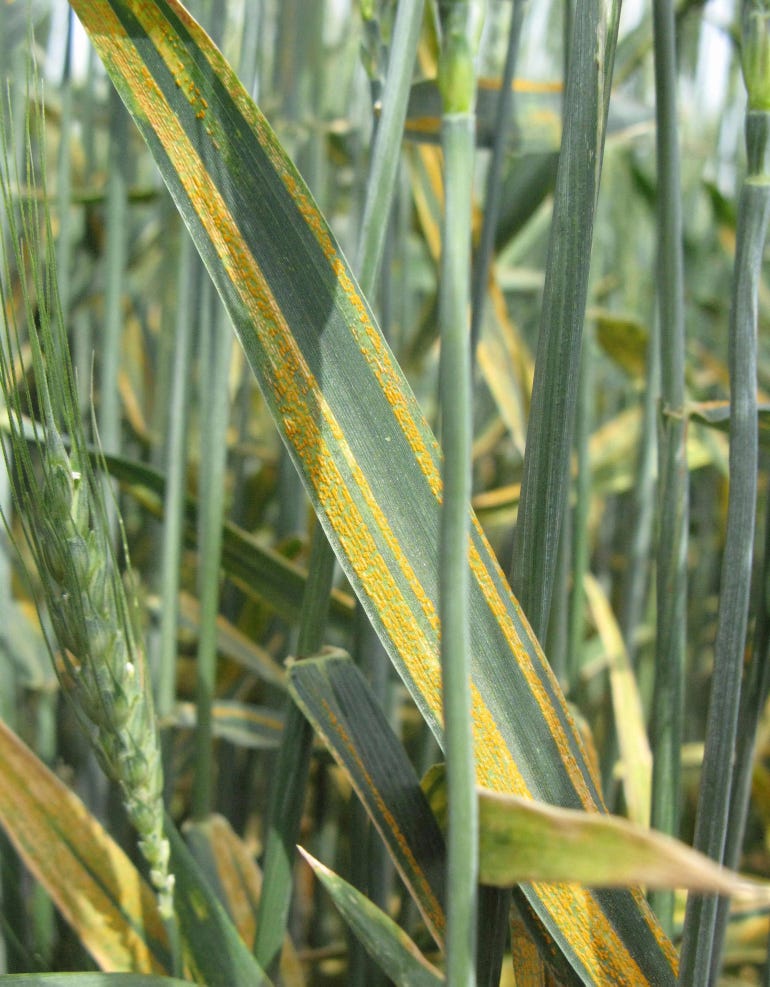
A cold, wet spring around Missouri may have triggered diseases in wheat this year.
Farmers should scout wheat fields for early warning signs of disease damage from cool temperatures combined with rain showers that occurred in April and May. Kaitlyn Bissonnette, University of Missouri Extension plant pathologist, says some wheat diseases can be treated with a fungicide application if caught early.
Wheat diseases to watch
Septoria leaf blotch is a disease that comes out of prolonged wet weather conditions. “It is a lower canopy disease, and you can find it in most seasons,” Bissonnette says. However, it can move up to the wheat head.
Soon after infection, lesions appear on the leaf. They appear as light yellow flecks or streaks. These lesions can expand and turn reddish-brown or dark brown.
According to Purdue University Extension, the lesions will produce spores within 10 to 20 days, which can in turn be splashed up into higher layers of the canopy, eventually infecting the flag leaves. From there, new spores can splash onto, and infect, the wheat heads.
Moderately warm weather ranging from 68 to 82 degrees F combined with frequent rain and high humidity aid in the movement of the disease. Ultimately, Bissonnette says, this movement of infection to the flag leaf can result in Stagonospora glume blotch. “This can sometimes be purely aesthetic and sometimes can affect grain quality," she says.
Once the temperatures warm up, she notes, the disease dissipates.

LOOK AT LEAVES: Stripe rust looks much like it sounds, a red line running along the wheat leaf. Typically, this wheat disease is found in the Southern states, but has been shown to move north and into Missouri as it prefers a humid atmosphere.

Stripe rust likes cool weather
Another disease favored by cool, wet weather is stripe rust. This fungus disease thrives when temperatures are in the 50s.
“It rose up from the Southern states,” Bissonnette says. “It has already been detected in wheat fields in northern Louisiana this year with several parishes reporting it.” Stripe rust is predicted to go even farther north and is a problem for Missouri wheat growers.
In years where the weather is wet and cool, stripe rust has caused significant yield losses when not controlled. Bissonnette points to areas such as the Pacific Northwest where farmers saw up to 40% yield loss.
“We likely will not see anything near that level,” she says, “but it’s important to monitor and detect this in each county, especially when temperatures remain cool.”
Like Stagonospora glume blotch, once the weather warms, stripe rust becomes less of an issue.
Warm weather wheat disease
Powdery mildew can persist in cool, cloudy and especially humid conditions where relative humidity is 70% to 90%.
The infection appears as light-green or yellow flecks on the leaf surface. As powdery mildew develops, the leaf surfaces become covered with patches of cottony white mold growth, which eventually turn a grayish-white to grayish-brown in color.
Bissonnette says the susceptibility of wheat to this disease largely depends on wheat variety. “A lot of the varieties that come out of Missouri breeding programs tend to be more resistant to powdery mildew,” she explains, “but those that come out of much more arid climates like the Oklahoma State program tend to be a little more susceptible to powdery mildew.”
If farmers have a problem with powdery mildew this year, they may need to look first at variety. Next year, she notes, choosing one based on resistance level is important. Beyond wheat variety selection, control and management of this wheat disease is difficult.
Fungicide for fusarium
During the flowering stage in the next couple of weeks, farmers need to be thinking about management of fusarium head blight. This disease likes warmer temperatures in the 75- to 85-degree range.
Bissonnette says if flowering comes during warmer temperatures with higher humidity, anything greater than 90%, farmers may want to consider a fungicide application. Timing of application matters. She recommends a fungicide application at flowering where it is 50% flowering in the field. And up to six days after flowering, farmers can have “similar control to reduce mycotoxins and disease in the field.”
However, she warns wheat growers to avoid strobilurin fungicides, because these can be shown to increase mycotoxins in the grain and reduce quality.
Assessing wheat disease damage this year can help in planning for the next growing season.
About the Author(s)
You May Also Like






